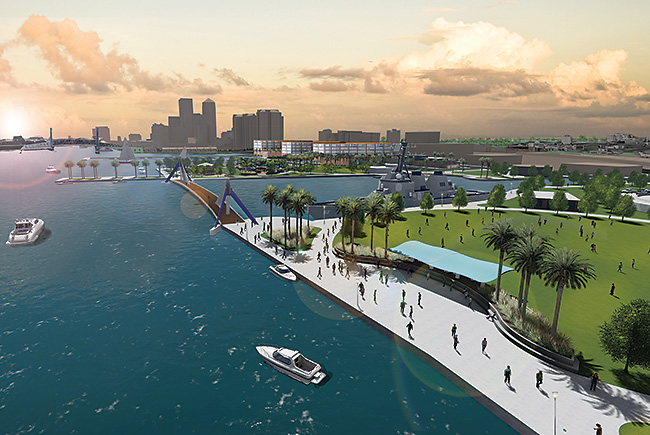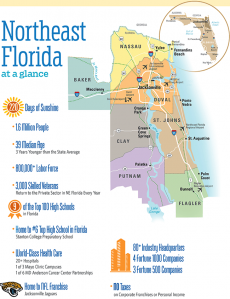Downtown Jacksonville

Take a good look around Jacksonville and the rest of Northeast Florida.
Close your eyes and commit those images to memory.
When you open them again, you may not recognize what you see.
The seven counties of Northeast Florida (Baker, Clay, Duval, Flagler, Nassau, Putnam and St. Johns) are embarking on a transformational period, with a number of projects that are changing the face of the region.
These include mixed-use communities and economic development initiatives that will change how residents live, work and play.
The coming transformation starts with a journey through downtown Jacksonville on the St. Johns River, one of many waterways that stamp the region. Two massive projects on both sides of the river are altering the landscape.
The Shipyards
A quarter-century after the downtown ship building and repair facility closed, the 70-acre property along the river is coming back to life. The mixed-use development that includes a hotel, residences, offices, restaurants and retail establishments will entail more than $500 million in private investment.
The property is close to EverBank Field, home of the Jacksonville Jaguars, which is no coincidence because developer Iguana Investments is backed by Jaguars owner Shad Khan.
Already in 2017, the Jaguars opened the 5,500-seat Daily’s Place amphitheater adjacent to the football stadium. Khan and the Jaguars management see development of the area near the downtown sports complex as a key to the team’s long-term success.
Jaguars President Mark Lamping sees the football team continuing to grow in stature and fan support as Jacksonville continues to grow. He expects the Shipyards project to be a catalyst for growth of both.
“As far as the franchise goes, we’re only going to go as far as downtown Jacksonville goes,” Lamping says.
The District
Across from the shipyards on the Southbank of the St. Johns River, another new community is sprouting up.
The District will include a hotel along with shops and restaurants. But the real appeal of the new community is its healthy living concept. The project will include bike paths and fitness centers to promote daily fitness for residents of all ages.
Developer Peter Rummell says The District will appeal to residents from 30 to 80 who embrace the healthy lifestyle.
“That’s what makes it different and special,” he says.
Rummell is known for creating new communities. As chairman of Walt Disney Imagineering in the 1990s, he began development of Celebration, a 20,000-resident planned community near Walt Disney World.
A decade later as CEO of The St. Joe Co., he began developing thousands of acres of land in the Florida Panhandle, including the 499-acre community of WaterColor on the Gulf of Mexico.
Rummell says the waterfront location of The District will make it appealing. “You don’t get 30 acres on a big amenity like that very often.”
Renovation projects are bringing new life to historic buildings that have long been shuttered, including a high-end restaurant and a mixed-used development in the heart of downtown.
The Laura Street Trio
While the river grabs your attention immediately, transformational projects are also underway a few blocks inland in downtown Jacksonville.
The Laura Street Trio consists of three buildings all more than 100 years old that are being redeveloped along with a 91-year-old, 18-story building that once served as the headquarters for Barnett Bank.
Work has already begun on the Barnett Bank Building, which will be renovated for office space and apartments. The Trio buildings will be redeveloped into a hotel, restaurants and offices.
The $78 million project is a partnership between a local company, Southeast Development, and the Las Vegas-based Molasky Group.
Southeast Development principal Steve Atkins expects the redevelopment of the historic, but long-vacant, space will reinvigorate the neighborhood.
“This will create a 24-hour node of activity right in the heart of downtown,” he says.
Cowford Chophouse
With all of the large-scale projects on the horizon, the opening of a single downtown restaurant may not seem like a big deal. But the opening of the Cowford Chophouse in 2017 generated a lot of buzz.
Owner Jacques Klempf opened the restaurant in the historic Bostwick Building, a Jacksonville landmark opened in 1902 that was one of the first buildings constructed after the Great Fire of 1901 decimated the city.
The restaurant’s name pays homage to the city’s history, as Cowford was the original name of the village before it was renamed Jacksonville in 1822.
The Bostwick Building had fallen into disrepair before
Klempf bought it in 2014 and began restoring it to preserve its history, while also creating a new downtown dining spot.
With the help of agencies including the city’s Historic Preservation Trust Fund, restoration work of the building included historic arched windows, exterior bricks, metal cornice, and 300-year-old heart of pine lumber.
“He was willing to move forward and spend enormous amounts of money,” says Jerry Mallot, president of JAXUSA Partnership.
Transportation officials are planning for future growth of the area, with projects that will change the way people move around downtown and new highways to move drivers faster between counties.
Jacksonville Regional Transportation Center
The Jacksonville Transportation Authority (JTA) is creating a new transportation hub, near the Prime Osborn Convention Center, that will connect the city bus system with Greyhound and other intercity bus carriers, as well as future Amtrak and commuter rail stations.
“The Jacksonville Regional Transportation Center (JRTC) will become an economic catalyst for the region and for the many people who worked to build the regional transportation networks we use today and rely on for our livelihood,” says JTA CEO Nat Ford.
The JRTC will also connect to the Ultimate Urban Circulator, a system that will upgrade the current Automated Skyway Express rail system to transport workers and visitors around the city.
JTA envisions using Autonomous Vehicles that can transport people with peak efficiency along the Skyway system.
First Coast Expressway
It’s not just downtown Jacksonville that is changing. Major projects are altering the landscape throughout the seven-county Northeast Florida region.
The first leg of the First Coast Expressway, a new tollway running from the Westside of Jacksonville through Clay County into St. Johns County, is opening in 2018.
Projections of strong population growth in Clay County prompted construction of the new highway, giving county residents easier connectivity to the surrounding communities.
“This was a need for their community,” says Hampton Ray of the Florida Department of Transportation. “We’re seeing some tremendous growth in the region.”
The first segment of the 46-mile tollway connects I-10 in Jacksonville to Blanding Boulevard. The second leg will run from Blanding to State Road 16 at the St. Johns River.
The final leg includes a new bridge across the river, where the Shands Bridge currently stands, with the road connecting to I-95 in St. Johns County.
As the region grows, new communities are sprouting in suburban areas, giving residents more places to live and relax in St. Johns and Nassau counties.
Nocatee and Beyond
When the First Coast Expressway is extended to St. Johns County, it will bring you close to Nocatee, the sprawling 13,323-acre development mainly in northern St. Johns County that extends partially into southern Duval County.
Nocatee has already transformed the region, certified by real estate advisory firm RCLCO as the third-fastest selling master planned community in the country.
RCLCO reported sales of 973 homes in 2016 in Nocatee after 1,105 homes were sold in 2015, when it was also ranked as the third best-selling community.
Melissa Glasgow, director of economic development for St. Johns County, says Nocatee attracts new residents with distinctive neighborhoods within the community.
“Their popularity remains high as they continue to add new housing options at varying price points to further diversify their community offerings,” she says.
The growth of Nocatee is spurring more development nearby in northern St. Johns, Glasgow says.
For example, Twin Creeks/Beachwalk is a 1,000-acre project that will include 3,000 residences plus 2 million square feet of retail and commercial space. A 14-acre Crystal Lagoon amenity features a private beach club and sparkling blue water for swimming, sailing and other activities.
Also under development in northern St. Johns County is Durbin Park, a 1,600-acre project that will open with 700,000 square feet of retail space.
Wildlight
When you cross the state line into Northeast Florida, one of the first things you’ll find is the new Wildlight development in Nassau County.
Wildlight, part of the 38-square-mile East Nassau Community Planning Area, is being developed by Rayonier, which already moved its corporate headquarters into a 55,000-square-foot office building. Besides that building, a 600-student Wildlight Elementary School opened in 2017.
Rayonier is a forest products company with thousands of acres of timberland in the region. A decade ago, the company saw an opportunity for commercial development on properties it owns along the I-95 corridor.
When it started the Wildlight project in 2016, Rayonier decided it was an ideal location to consolidate its three Northeast Florida offices.
Wildlight will eventually have 3,200 rooftops and 6.8 million square feet of non-residential space.
“What’s happening here is a new city is coming out of the ground in Nassau County,” says Laura DiBella, executive director of the Nassau County Economic Development Board.
With more than $1 billion in projects on the horizon, the future of downtown Jacksonville looks exciting. But supporters of downtown are not waiting.
Since the beginning of 2016, a number of smaller projects adding up to more than $900 million have been completed or are in progress, according to nonprofit Downtown Vision.
Those projects include new restaurants at Brooklyn Station and Unity Plaza at the west end of downtown to Intuition Ale Works, a microbrewery and tap room near the sports complex on the east end.
The sports complex area has traditionally been silent on days when there are no events.
“Intuition Ale Works has reinvigorated that area,” says Jacob Gordon, CEO of Downtown Vision.
The downtown Jacksonville district has 13 culture and entertainment venues and 112 bars and restaurants packed into 2.7 square miles.
One of the highlights of the downtown area is the First Wednesday Art Walk, a monthly event drawing about 8,000 people to see local artists and also check out museums and dining in the core of downtown.
Even for companies that bring jobs to the suburbs, Gordon says a vibrant downtown is an important signal to potential employers.
Downtown growth is not limited to entertainment. “Downtown is a recruiting tool for our city to attract and retain talent,” he says. “This is a good investment on a long-term scale.”
Jacksonville University, with its main campus along the St. Johns River northeast of downtown, opened a downtown campus in 2017.
JU is offering about 100 undergraduate and graduate programs at its 15,000-square-foot facility in the SunTrust Tower.
More businesses are also locating in downtown. Downtown Vision says the office vacancy rate in 2016 fell to 15.4%. That was the first time in a number of years that the downtown vacancy rate was below the suburban office vacancy rate, which was 16.2%.
“We’re really excited that number is now down,” says Gordon.
Nearly 60,000 people come to work downtown every day. Gordon says 4,000 to 5,000 people live in the downtown district, but that number is expected to grow as more housing units become available in the coming years.
“We really, truly feel people are returning to the urban core,” Gordon says.
Downtown Jacksonville
- $909.9 MILLION -- Active and Completed Developments since January 2016
- $1.1 BILLION -- Proposed Developments
- 2.7 SQUARE MILES -- Historic Core and Central Business District
- 90 BLOCK -- Business Improvement District

